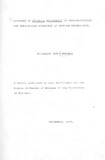| dc.description.abstract | The sonic extracts of Brucella melitensis Strain 16M were studied in agar gel immunodiffusion test after they had undergone differential centrifugation and concentration. The number of precipitin lines obtained varied with the antigenic fractions used and the method of hyperimmune serum preparation. The maximum number of precipitin lines demonstrated was six when a sonic extract of phenol treated B_. melitensis cell suspension, which had been centrifuged at 100,000 g for 60 minutes and concentrated (denoted j was reacted
against ahyperimmune serum prepared by intravenously inoculating a live melitensis suspension in saline into a rabbit. Line 4 was only observed when the above antigen was reacted with the standard B. melitensis hyperimmune serum (denoted MHS).
Line 5 was found to be due to a group specific antigenic component. Precipitin line number 6 was elicited by a lipopolysacchride protein complex of the cell wall which apparently carries the agglutinogens M and A. The rest of the lines were considered due to subsurface or cytoplasmic antigens.
Phenolised antigenic fractions/were found to give better reactions than acetone fractions in the indirect hemagglutination test with tanned sheep red blood cells. The above antigen C^gg1-) gave the
best reaction of all the phenol antigenic fractions. Gluteraldehyde fixed tanned sheep erythrocytes gave even better reaction than tanned cells in the IHA reaction. All antigenic fractions, both phenolised and acetonised, were capable of eliciting complement fixation reactions. However, these fractions offered little advantage over the whole cell antigen in the CFT.
Micro-AGIT was found to be more efficient than either the macro- or minimicro-methods. Antigen P^qqC was found to give the most consistent results in the AGIT and hence was used to detect infection in naturally and experimentally infected goats. These results were compared to the results of SAT, CFT and RBPT. The AGIT was useful for confirming animals with equivocal titres in the SAT and CFT. The RBPT was oversensitive and also gave a number of false negative reactions. The CFT was the most specific test giving the maximum number of reactors.
The SAT would be of little value if used in
combination with other tests. The combination
CFT - RBPT or CFT - AGIT would provide most of the
necessary information. However, for the detection
of maximum number of reactors in an infected herd
of goats, all four tests would be useful. In places
where CFT facilities are not available, the combination of RBPT - AGIT would help in detection of a good number of reactors. The use of IHAT for
the diagnosis of caprine brucellosis should be assessed further.
The serological response of infected goats tended to be similar. Agglutinins appeared first, followed by antibodies for the AGIT and RBPT, and finally CFT. The CFT, RBPT and AGIT remained reactive for a long period whereas the SAT became suspicious or negative early in infected goats. The initiation and magnitude of the response depended on the dose and the route of infection with
B. melitensis.
Abortions were the prominent sign with a suggestion of presence of infertility in the infected goats. Brucella organism was isolated only in the early stages of infection. | en_US |



